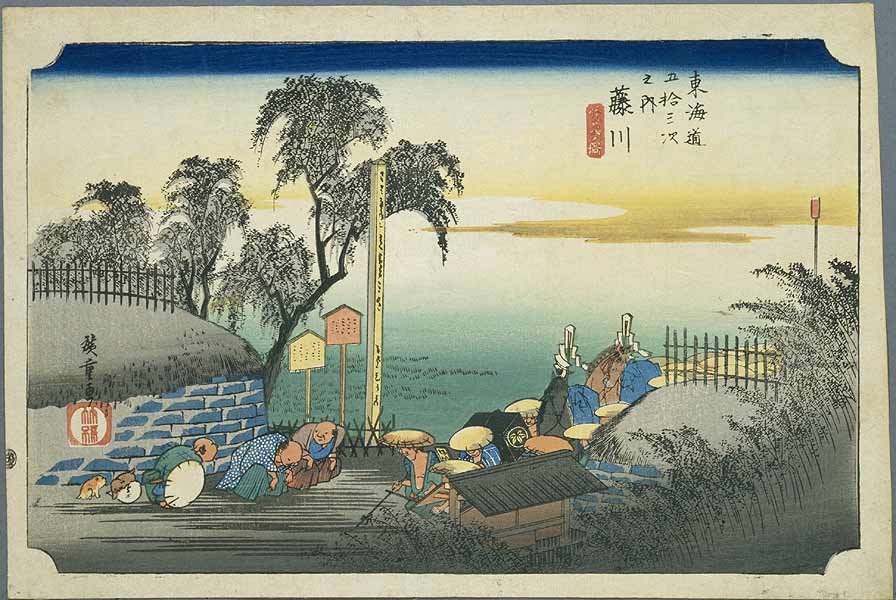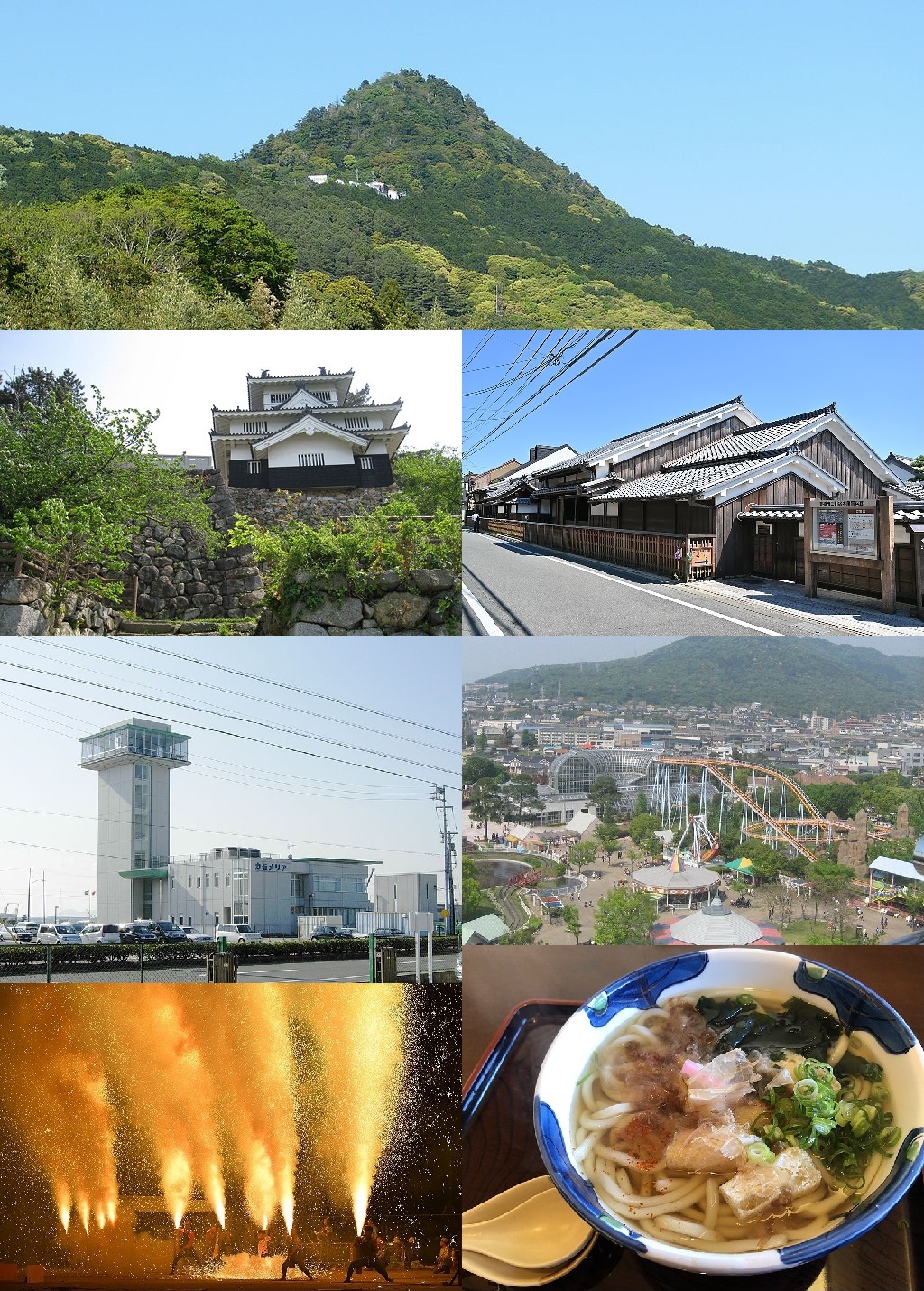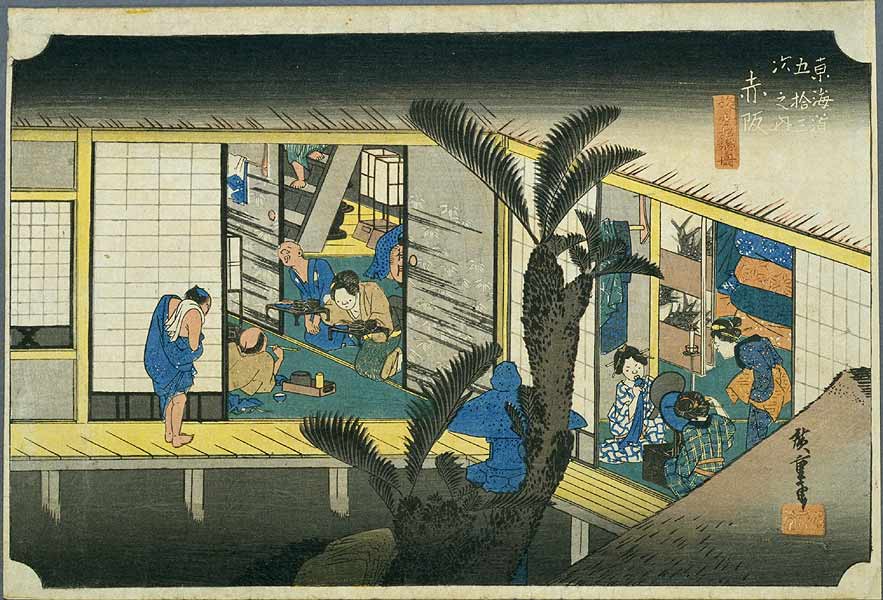|
Okazaki-juku
was the thirty-eighth of the fifty-three stations of the Tōkaidō. It is located in the present-day city of Okazaki, in Aichi Prefecture, Japan. History Okazaki-shuku was a part of the flourishing castle town surrounding Okazaki Castle, the headquarters for Okazaki Domain. The classic ukiyo-e print by Andō Hiroshige (Hōeidō edition) from 1831 to 1834 depicts a ''Yahagibashi'', one of the few bridges permitted by the Tokugawa shogunate on the Tōkaidō, and one of the longest bridges built in Japan during the early Edo period. Okazaki Castle is depicted in the distance on the far shore of the river. Following the Meiji restoration, with the construction of railroads, the route of what became the Tokaido Main Line was laid down through the nearby village of Hane ( ''Hane-mura'') to the south. Unlike Goyu-shuku and Akasaka-juku, but this did not cause a huge economic decline to Okazaki-shuku. There was a horse-drawn rail line connecting Okazaki to the train station, ... [...More Info...] [...Related Items...] OR: [Wikipedia] [Google] [Baidu] |
Shio No Michi
was an old ''kaidō'', or road, in ancient Japan and was used to transport salt from the ocean to the inland central Honshū. In the Middle Ages, salt was brought both from the Sea of Japan and the Pacific Ocean to Shinano Province for processing. The road leading from the Sea of Japan to Shinano Province was called the ''Chikuni Kaidō'' (千国街道), whereas the road leading from the Pacific Ocean was called the ''Sanshū Kaidō'' (三州街道).Shio no Michi wo Tabi Suru . Salt Road Museum. Accessed December 20, 2007. Stations of the Chikuni Kaidō On the Echigo Province side of the route, it was called the ''Itoigawa Kaidō'', but on the Shinano Province side, it was called ''Chikuni Kaidō''. The Sawado-juku and Sano-juku pair and the Ida-juku and Imori-juku pair each essentially functioned as one shukuba, pos ...[...More Info...] [...Related Items...] OR: [Wikipedia] [Google] [Baidu] |
Okazaki Castle
is a Japanese castle located in Okazaki, Aichi Prefecture, Japan. At the end of the Edo period, Okazaki Castle was home to the Honda clan, ''daimyō'' of Okazaki Domain, but the castle is better known for its association with Tokugawa Ieyasu and the Tokugawa clan. The castle was also known as . History Saigo Tsugiyori built an earthen-walled fortification in the Myodaiji area of Okazaki, near the present castle in 1455. Matsudaira Kiyoyasu, after gaining control of the area in 1524, demolished the old fortification and built Okazaki Castle on its present location. His famous grandson Matsudaira Motoyasu (later named Tokugawa Ieyasu) was born here on January 31, 1543. The Matsudaira were defeated by the Imagawa clan in 1549, and Ieyasu was taken to Sunpu Castle as a hostage. Following the defeat of the Imagawa at the Battle of Okehazama, Ieyasu regained possession of the castle in 1560 and left his eldest son Matsudaira Nobuyasu in charge when he moved to Hamamatsu C ... [...More Info...] [...Related Items...] OR: [Wikipedia] [Google] [Baidu] |
Meiji Restoration
The , referred to at the time as the , and also known as the Meiji Renovation, Revolution, Regeneration, Reform, or Renewal, was a political event that restored Imperial House of Japan, imperial rule to Japan in 1868 under Emperor Meiji. Although there were ruling emperors before the Meiji Restoration, the events restored practical power to, and consolidated the political system under, the Emperor of Japan. The Restoration led to enormous changes in Japan's political and social structure and spanned both the late Edo period (often called the Bakumatsu) and the beginning of the Meiji era, during which time Japan rapidly Industrialization, industrialised and adopted Western culture, Western ideas and production methods. The origins of the Restoration lay in economic and political difficulties faced by the Tokugawa shogunate. These problems were compounded by the encroachment of foreign powers in the region which challenged the Tokugawa policy of , specifically the arrival of the Pe ... [...More Info...] [...Related Items...] OR: [Wikipedia] [Google] [Baidu] |
Chiryū-juku
was the thirty-ninth of the fifty-three stations of the Tōkaidō. It is located in the present-day city of Chiryū in Aichi Prefecture, Japan. It was the westernmost post town in Mikawa Province, and was from Nihonbashi, the start of the Tōkaidō, so it took approximately 10 days to for average travellers to reach. History Chiryū-juku was noted for a famed Shinto shrine, the Chiryū Daimyōjin, and also for its flourishing horse market, held in late April to early May of each year. Tokugawa Ieyasu ordered that the post station plant pine trees along through route of the highway before and after the town. The classic ukiyo-e print by Andō Hiroshige (Hōeidō edition) from 1831 to 1834 depicts horses, and also one of the pine trees. Hiroshige entitled the work . Despite the construction of railroads following the Meiji restoration the horse market continued into the Shōwa period, and most of the pine trees survived until the 1959 Isewan Typhoon. Neighboring post to ... [...More Info...] [...Related Items...] OR: [Wikipedia] [Google] [Baidu] |
Fujikawa-shuku
was the thirty-seventh of the fifty-three stations of the Tōkaidō. It is located in the present-day city of Okazaki, in Aichi Prefecture, Japan. It was approximately from Akasaka-juku, the preceding post station.Tokaido 53: Fujikawa-juku (Okazaki) . Tōkaidō no Tabi. Accessed March 6, 2008. Another accepted reading for this post town is "Fujikawa-juku." At its peak, Fujikawa-juku was home to 302 buildings, including one '''', one sub-''honjin'' and 36 ''''. Its total population was approximately 1,200 people. The classic |
Shukuba
were Stage station, staging post stations during the Edo period in Japan, generally located on one of the Edo Five Routes or one of its sub-routes. They were also called ''shuku-eki'' (宿駅). These stage stations, or "" developed around them, were places where travelers could rest on their journey around the nation. They were created based on policies for the transportation of goods by horseback that were developed during the Nara period, Nara and Heian period, Heian periods. History These stations were first established by Tokugawa Ieyasu shortly after the end of the Battle of Sekigahara. The first stations were developed along the Tōkaidō (road), Tōkaidō (followed by stations on the Nakasendō and other routes). In 1601, the first of the Tōkaidō's 53 Stations of the Tōkaidō, fifty-three stations were developed, stretching from Shinagawa-juku in Edo to Ōtsu-juku in Ōmi Province. Not all the post stations were built at the same time, however, as the last one was bui ... [...More Info...] [...Related Items...] OR: [Wikipedia] [Google] [Baidu] |
World War II
World War II or the Second World War (1 September 1939 – 2 September 1945) was a World war, global conflict between two coalitions: the Allies of World War II, Allies and the Axis powers. World War II by country, Nearly all of the world's countries participated, with many nations mobilising all resources in pursuit of total war. Tanks in World War II, Tanks and Air warfare of World War II, aircraft played major roles, enabling the strategic bombing of cities and delivery of the Atomic bombings of Hiroshima and Nagasaki, first and only nuclear weapons ever used in war. World War II is the List of wars by death toll, deadliest conflict in history, causing World War II casualties, the death of 70 to 85 million people, more than half of whom were civilians. Millions died in genocides, including the Holocaust, and by massacres, starvation, and disease. After the Allied victory, Allied-occupied Germany, Germany, Allied-occupied Austria, Austria, Occupation of Japan, Japan, a ... [...More Info...] [...Related Items...] OR: [Wikipedia] [Google] [Baidu] |
Toyohashi, Aichi
is a Cities of Japan, city in Aichi Prefecture, Japan. , the city had an estimated population of 377,453 in 160,516 households and a population density of 1,400 persons per km2. The total area of the city was . By area, Toyohashi was Aichi Prefecture's second-largest city until March 31, 2005, when it was surpassed by the city of Toyota, Aichi, Toyota, which had merged with six peripheral municipalities. Geography Toyohashi is located in southeastern Aichi Prefecture, and is the capital of the informal "Higashi-Mikawa Region" of the prefecture. It is bordered by Shizuoka Prefecture to the east, and by Mikawa Bay and the headlands of the Atsumi Peninsula to the west. To the south is the Enshū Sea of the Pacific Ocean. The presence of the warm Kuroshio Current offshore gives the city a temperate climate. The stretching in adjacent city of Tahara to the west, Toyohashi, and the city of Hamamatsu to the east is a sea turtle nesting spot. Climate The city has a climate characterized ... [...More Info...] [...Related Items...] OR: [Wikipedia] [Google] [Baidu] |
Akasaka-juku (Tōkaidō)
was the thirty-sixth of the fifty-three stations of the Tōkaidō. It is located in present-day Toyokawa, Aichi Prefecture, Japan. It was only from Goyu-juku, the preceding post station. History Along with the preceding Yoshida-juku and Goyu-shuku, Akasaka-juku was well known for its '' meshimori onna''. The classic ukiyo-e print by Andō Hiroshige (''Hoeido'' edition) from 1831–1834 depicts a typical inn; the scene is divided in half by a sago palm in the center. To the right, travellers are taking their evening meal, and to the left, prostitutes are putting on make-up and preparing for the evening entertainment. Due to its reputation, Akasaka was a popular post station with many travellers. Ōhashi-ya (大橋屋), an inn that first opened in 1649, less than half a century after the creation of the Tōkaidō, still operates today. The building it uses was built in 1716. During a census in 1733, there were 83 inns in Akasaka-juku, but only Ōhashi-ya remains to ... [...More Info...] [...Related Items...] OR: [Wikipedia] [Google] [Baidu] |
Goyu-shuku
was the thirty-fifth of the 53 Stations of the Tōkaidō, fifty-three stations of the Tōkaidō (road), Tōkaidō. It is located in Goyu-chō in the city of Toyokawa, Aichi, Toyokawa, Aichi Prefecture, Japan. A pine tree colonnade, one of the few remnants from the Edo period shukuba, post town, is a well-known tourist spot. It was approximately from Yoshida-juku, the preceding post station. History Goyu-shuku was established in 1601, at the behest of Tokugawa Ieyasu. At its most prosperous, there were four ''honjin'' in the post town, though there were never less than two at any point. The classic ukiyo-e print by Andō Hiroshige (Hōeidō edition) from 1831 to 1834 depicts the main street of the post town at dusk, with aggressive female touts (for which the post station was infamous) attempting to drag travellers into teahouses and inns for the night. During the Meiji Restoration, the central office for the Hoi District, Aichi, Hoi District, making it the center of the distric ... [...More Info...] [...Related Items...] OR: [Wikipedia] [Google] [Baidu] |







